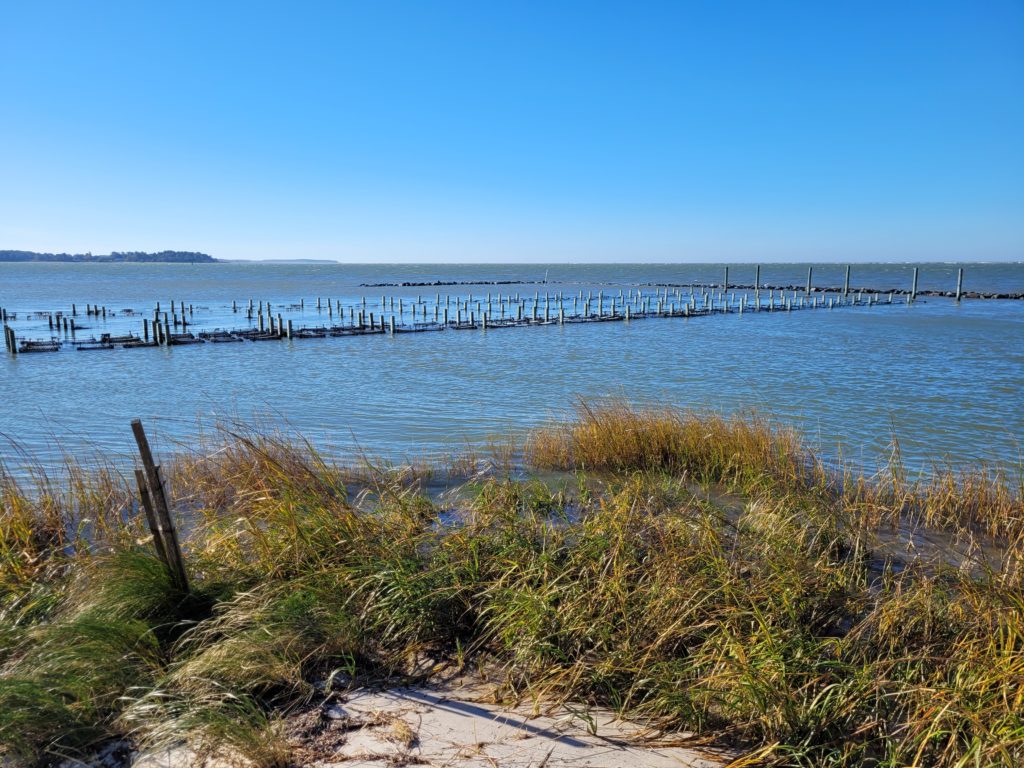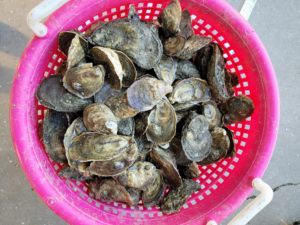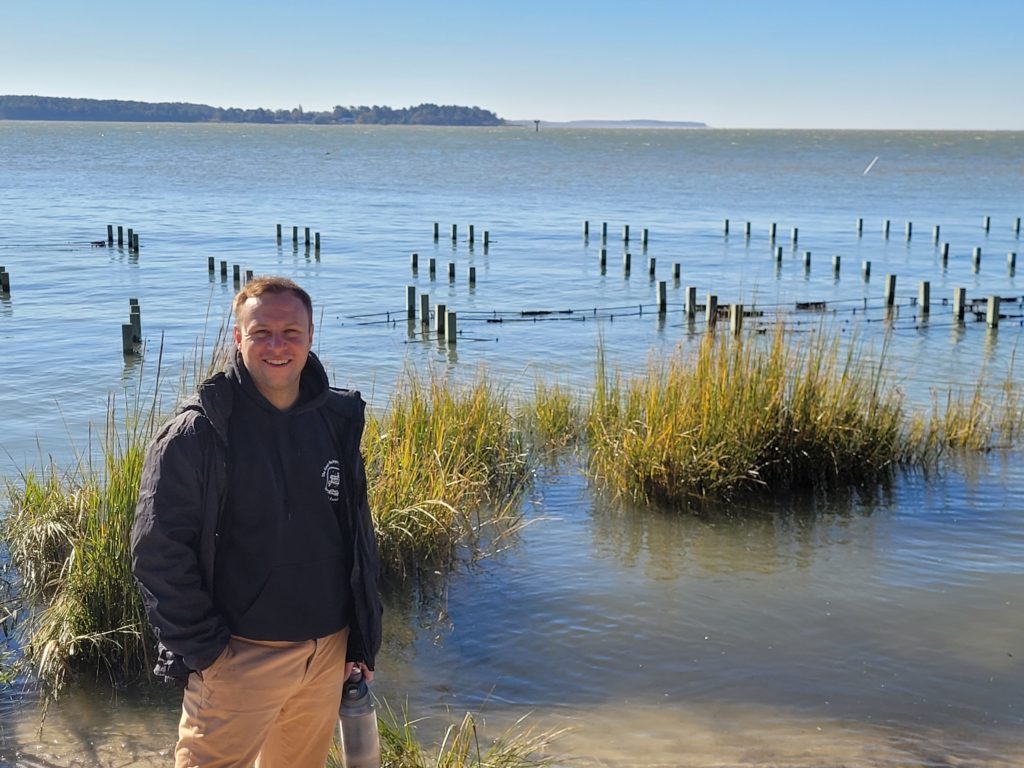For anyone that has sat down and had conversations with watermen in coastal Virginia, you’ve probably heard them say that working on the water is just “in their blood.” They’ve been working on the water their whole lives. They come from a long line of watermen in their family. The creek they live on has been in the family for generations. It makes them who they are. They have beautiful stories to tell, and sometimes difficult stories to tell, about what it’s like to make a living on the water. Simply put, it’s “in their blood.” And we cherish those people that keep a piece of coastal Virginia’s rich heritage alive.
But there seems to be some new blood in town. Young and hopeful entrepreneurs are trying their hand at working the water, but with a fresh spin. Instead of dredging or gathering oysters, they are farming oysters – raising them from tiny seed, sometimes by the millions!
One of these oyster farming success stories takes place in the tiny town of Machipongo, located on the Eastern shore, where a young entrepreneur, Alex Lambert, has been quietly growing more and more oysters for the last 3 years. But Alex’s story doesn’t begin in Machipongo. Far from it, actually. If you rewind just a few more years, you would have found Alex working for a top accounting firm in Manhattan. Talk about a change of pace!
In 2013, Alex’s family decided to purchase a second home on the Eastern shore. They stumbled across a unique property, located on a remote peninsula surrounded by the Chesapeake to the west, and Hungars Creek to the east. They immediately fell in love with the area.
Over the next 3 years, whenever Alex had a chance to escape city life and visit his family’s quiet Eastern shore retreat, he found himself becoming more and more curious about the watermen working just beyond the shoreline of their home. He soon began researching aquaculture – reading books, talking with neighbors, and watching YouTube videos. By 2016 he purchased his first batch of seed as an fun, experimental project to work on with his dad. They very quickly realized their spot on the creek could yield some delicious oysters! In 2018, Alex quit his job to build the farm full-time, and never looked back. Fast forward to today, and Lambert Shellfish is now producing nearly a million oysters each year!
Now, if you’ve been following Virginia Water Trails on social media, you know that Lambert Shellfish isn’t the only up-and-coming oyster farm in Virginia. From Rogue Oysters on the Northern Neck, to York River Oysters on the Middle Peninsula, following Virginia’s water trails can lead you to some delicious oyster farm tours and introduce you to some hard-working people and inspirational stories. But if you’ve seen one, you definitely haven’t seen them all. Each oyster farm operates a little differently, so even if you’ve toured some of the other farms already, Lambert Shellfish is definitely worth a visit and here’s why:
The entire growing operation is within 150 yards of the Lamberts’ home.

There’s no need to take a long boat ride out to the farm and there’s no need for an indoor upweller or nursery area. The quieter, protected waters of Hungars Creek provide an ideal spot to begin raising the seed. Oyster cages are hung along the length of their dock on the creek, and from there, the oysters are transferred to ground cages that are just a few feet from the shoreline. Fast forward a bit more and the oysters are then placed in the adjustable long-line system, conveniently constructed inside the small breakwaters that the previous property owner built in the early 2000s to minimize erosion to the property.
They allow Mother Nature to do a lot of the work.

 Alex refers to the cages that are suspended from their dock as the upweller. Most people that know anything about oyster farming would hear the word “upweller” and picture a large tank requiring pumps and electricity to fill and drain containers of oyster seed on a regular basis, which requires constant care and maintenance. But because of the Lamberts’ ideal spot on the creek, they are able to allow Mother Nature to do the work of nurturing and nourishing the tiny oysters. And it’s always a plus when electricity isn’t involved, both for environmental reasons and because power outages can be quite common in rural, coastal Virginia!
Alex refers to the cages that are suspended from their dock as the upweller. Most people that know anything about oyster farming would hear the word “upweller” and picture a large tank requiring pumps and electricity to fill and drain containers of oyster seed on a regular basis, which requires constant care and maintenance. But because of the Lamberts’ ideal spot on the creek, they are able to allow Mother Nature to do the work of nurturing and nourishing the tiny oysters. And it’s always a plus when electricity isn’t involved, both for environmental reasons and because power outages can be quite common in rural, coastal Virginia!
The long-line system at the mouth of the creek is set up in such a way that the oysters are actually out of the water during low tides. The oysters are naturally tumbled with the tides and waves of the bay, which yields a stronger shell and an oyster that’s packed with meat and easy to shuck.
Their story can’t be told without mentioning a little musical inspiration.
 The two main oyster products that come out of Lambert Shellfish are charmingly named, “Loving Cups” and “Rocky Tops”, inspired by famous songs covered by Alex’s favorite band, Phish. Their seed is purchased from a hatchery across the bay, and the owner of that hatchery just so happens to play in a bluegrass band. In fact, Alex and his wife recently got married at the oyster farm, and the hatchery owner’s band performed at the reception. Talk about a love of music and oysters! Don’t be surprised if Lambert Shellfish is offering some kind of waterfront concerts in the future!
The two main oyster products that come out of Lambert Shellfish are charmingly named, “Loving Cups” and “Rocky Tops”, inspired by famous songs covered by Alex’s favorite band, Phish. Their seed is purchased from a hatchery across the bay, and the owner of that hatchery just so happens to play in a bluegrass band. In fact, Alex and his wife recently got married at the oyster farm, and the hatchery owner’s band performed at the reception. Talk about a love of music and oysters! Don’t be surprised if Lambert Shellfish is offering some kind of waterfront concerts in the future!
Lambert Shellfish welcomes visitors and tours by land and by water. Their farm is surrounded by sandy beaches, convenient and perfect for those visiting by kayak or paddleboard. If you order ahead and bring a cooler, you can even bring some of their harvest home with you – directly from the farm to your table.

Happy water trails!
About the Author: Laura Scharle lives on the Eastern shore of Maryland and is a frequent paddler in coastal Virginia. She is a Virginia certified ecotour guide and is an independent marketing contractor with a focus in ecotourism and heritage tourism. Laura can be reached through our Eastern Shore ecotour guide listings.
